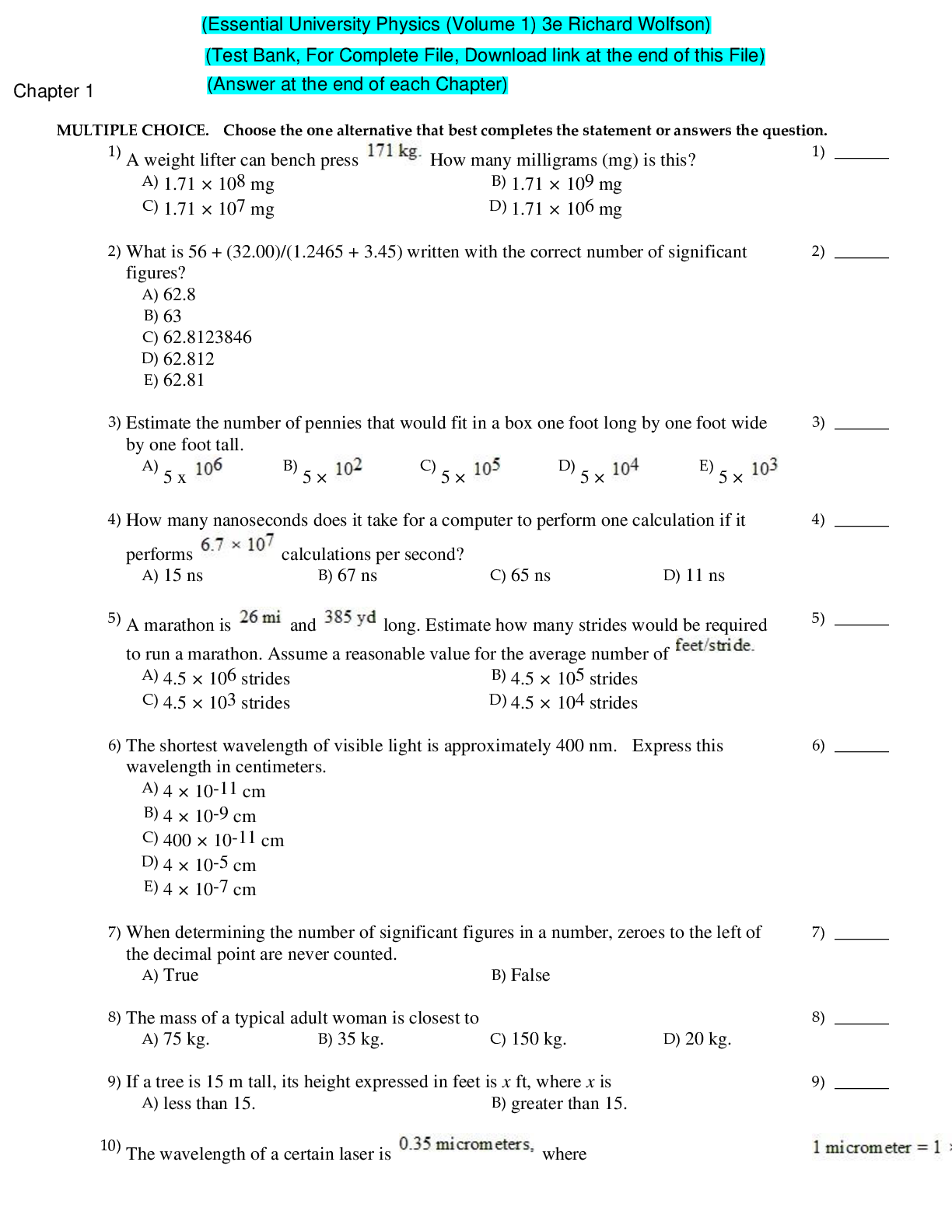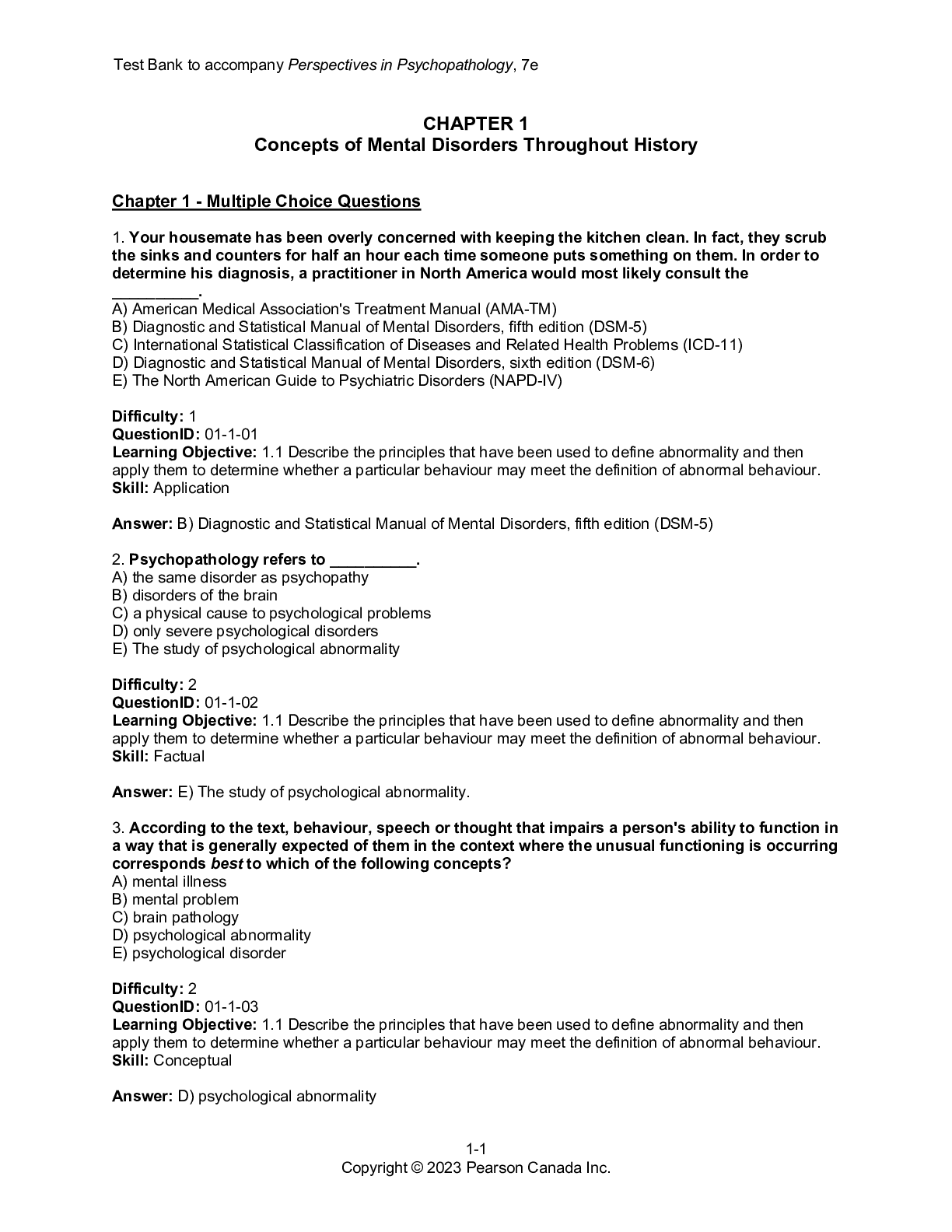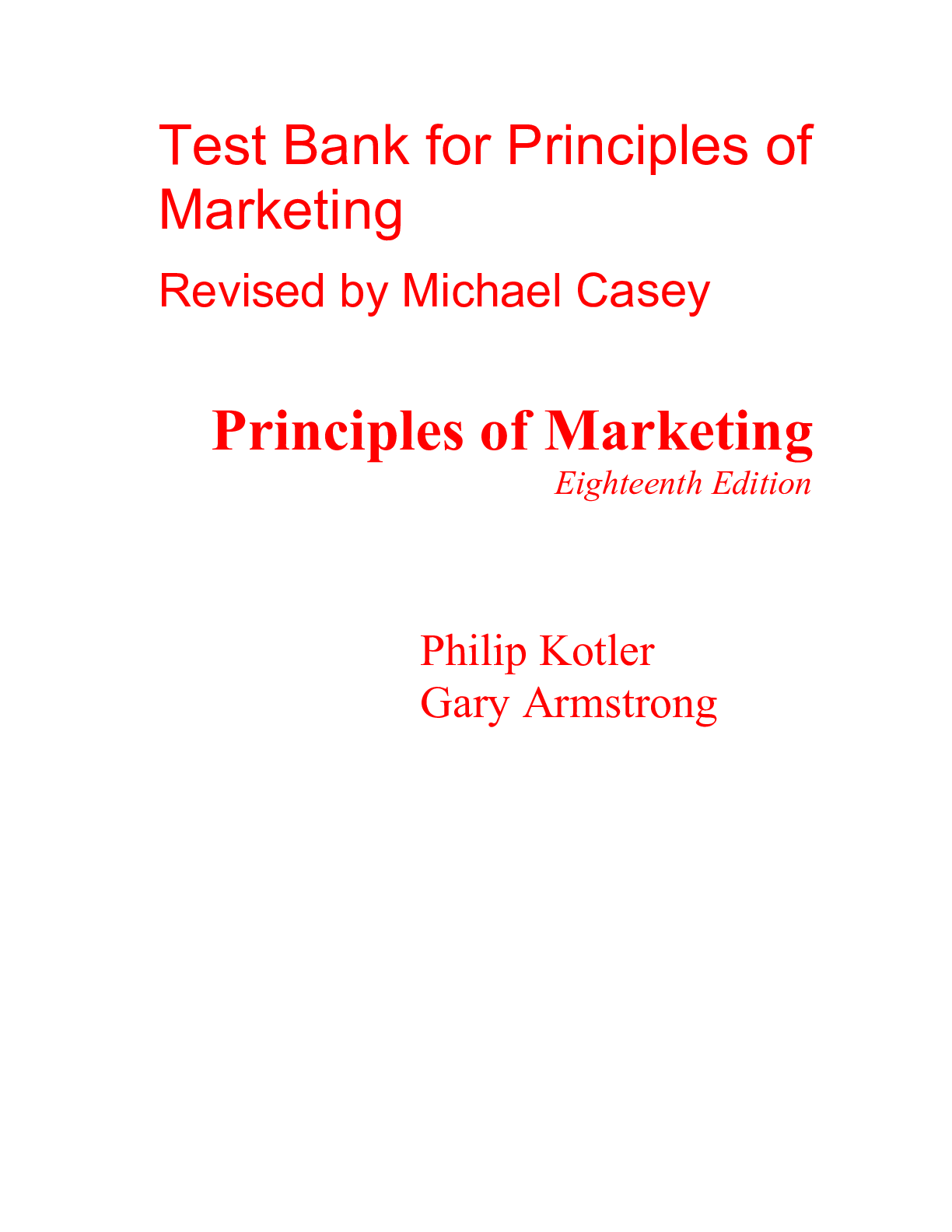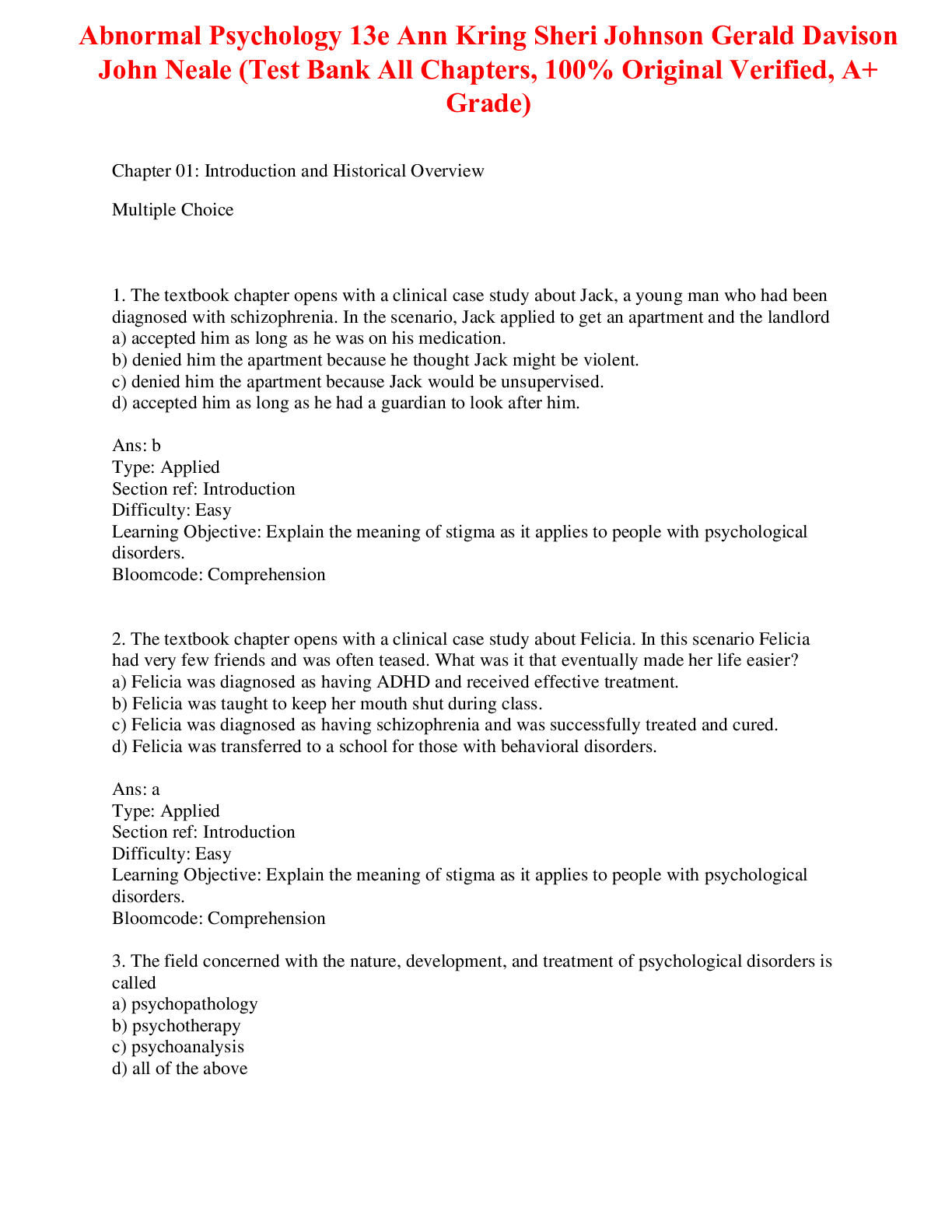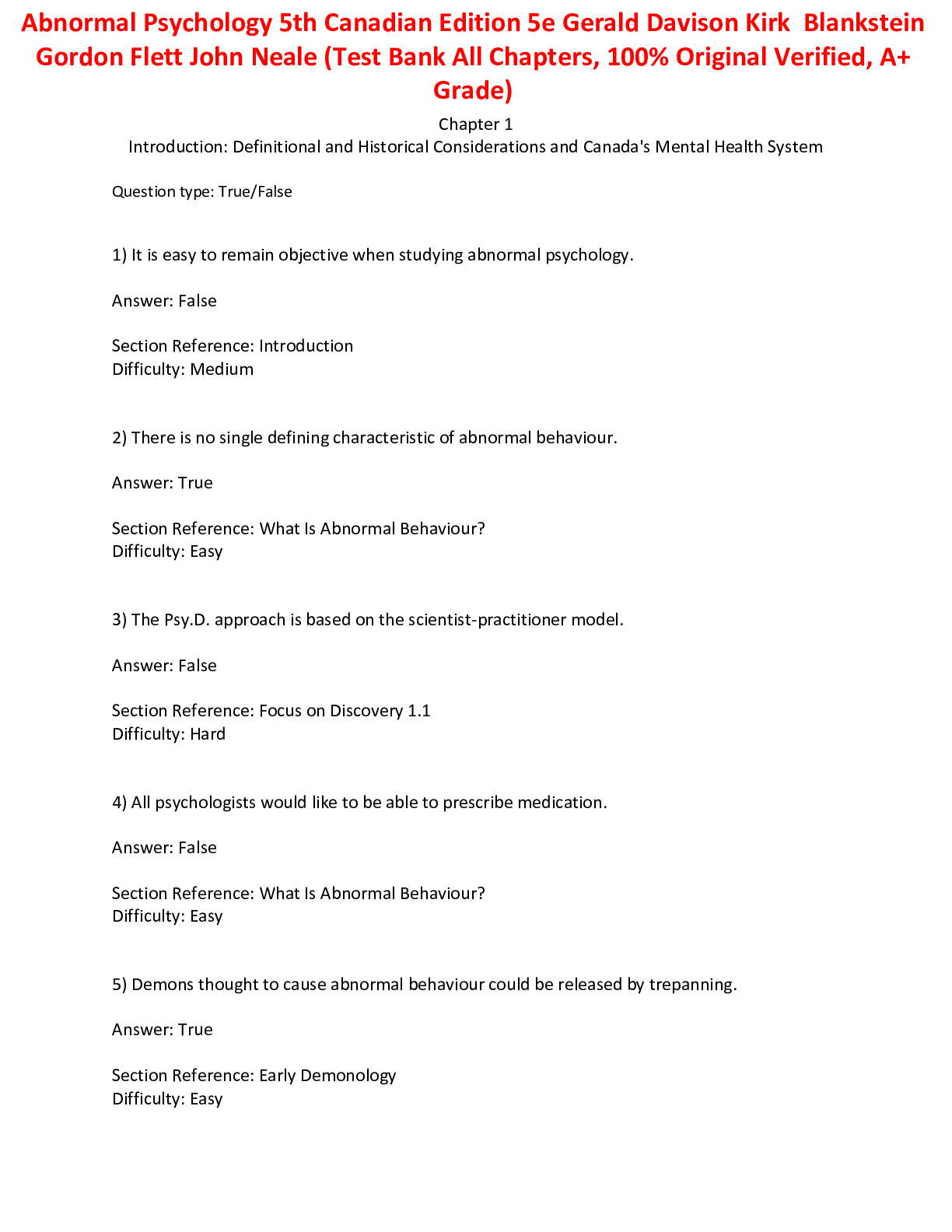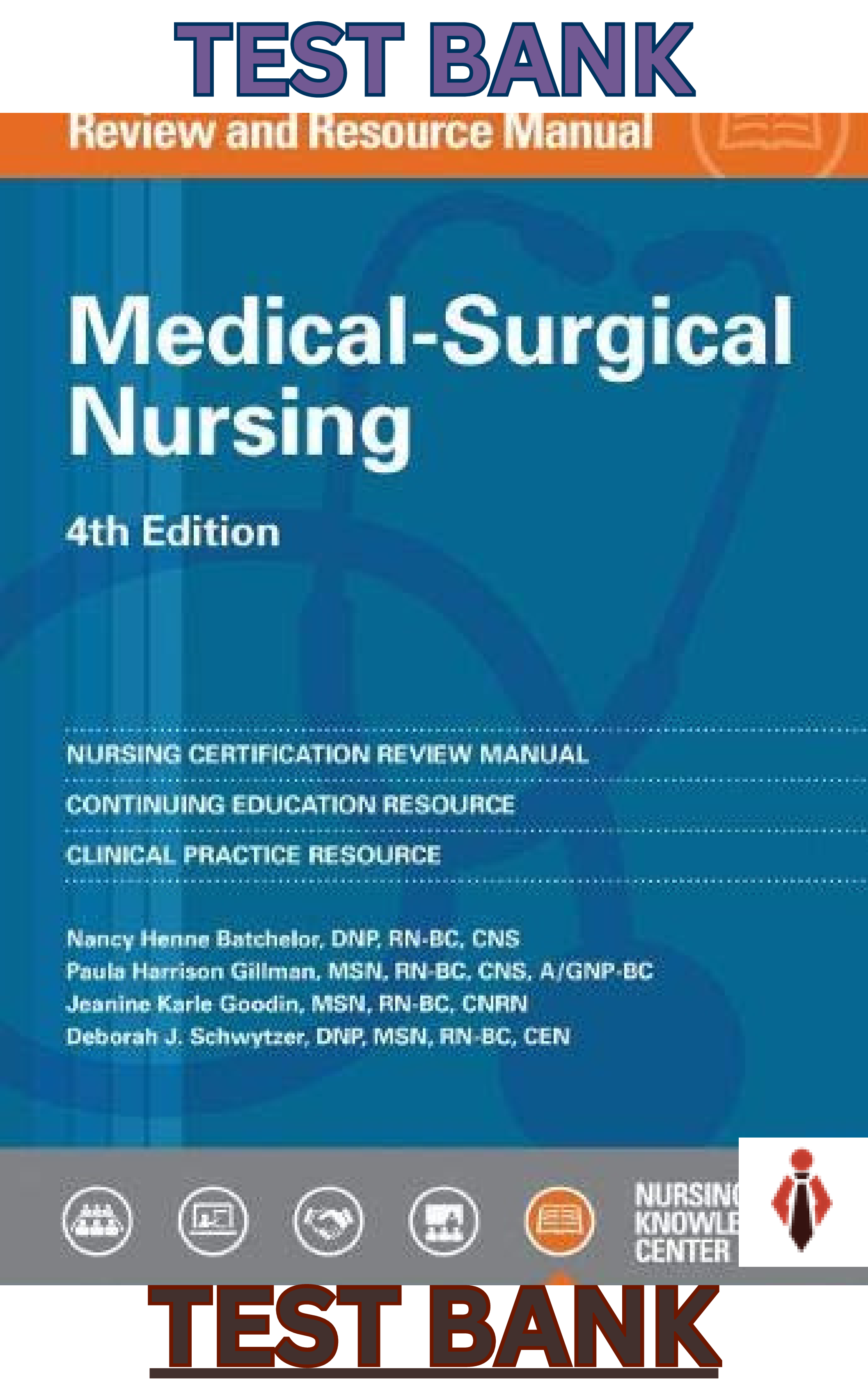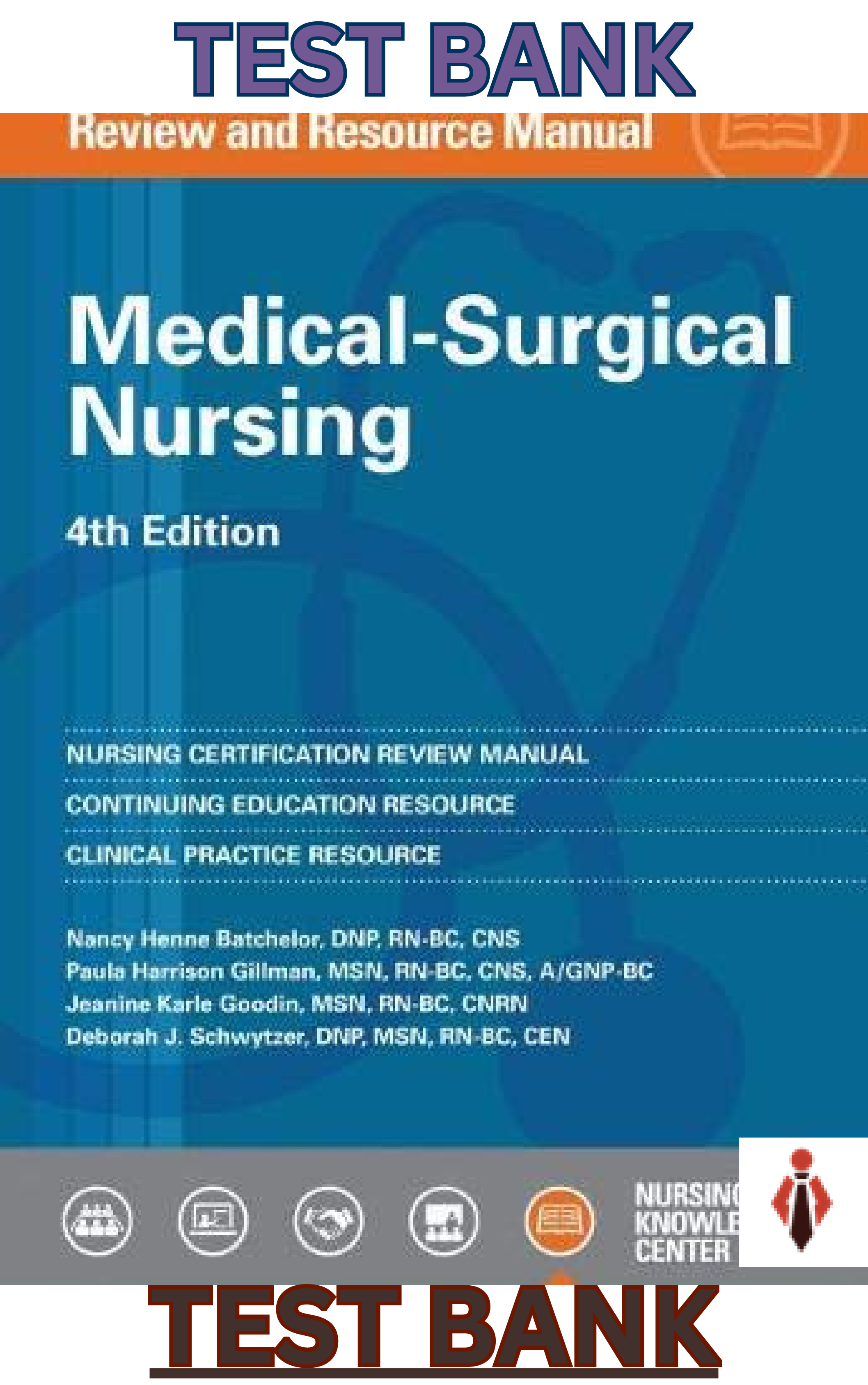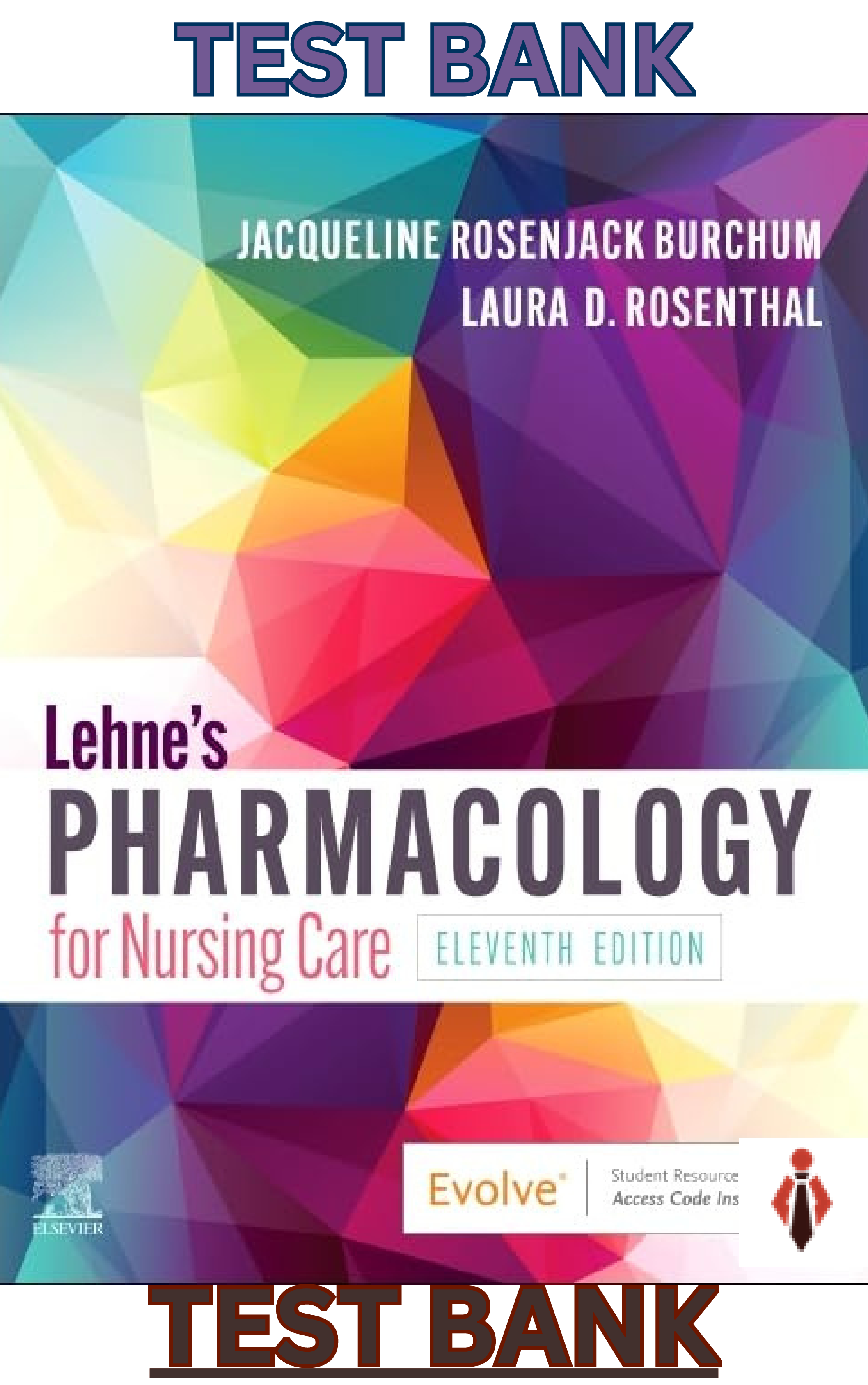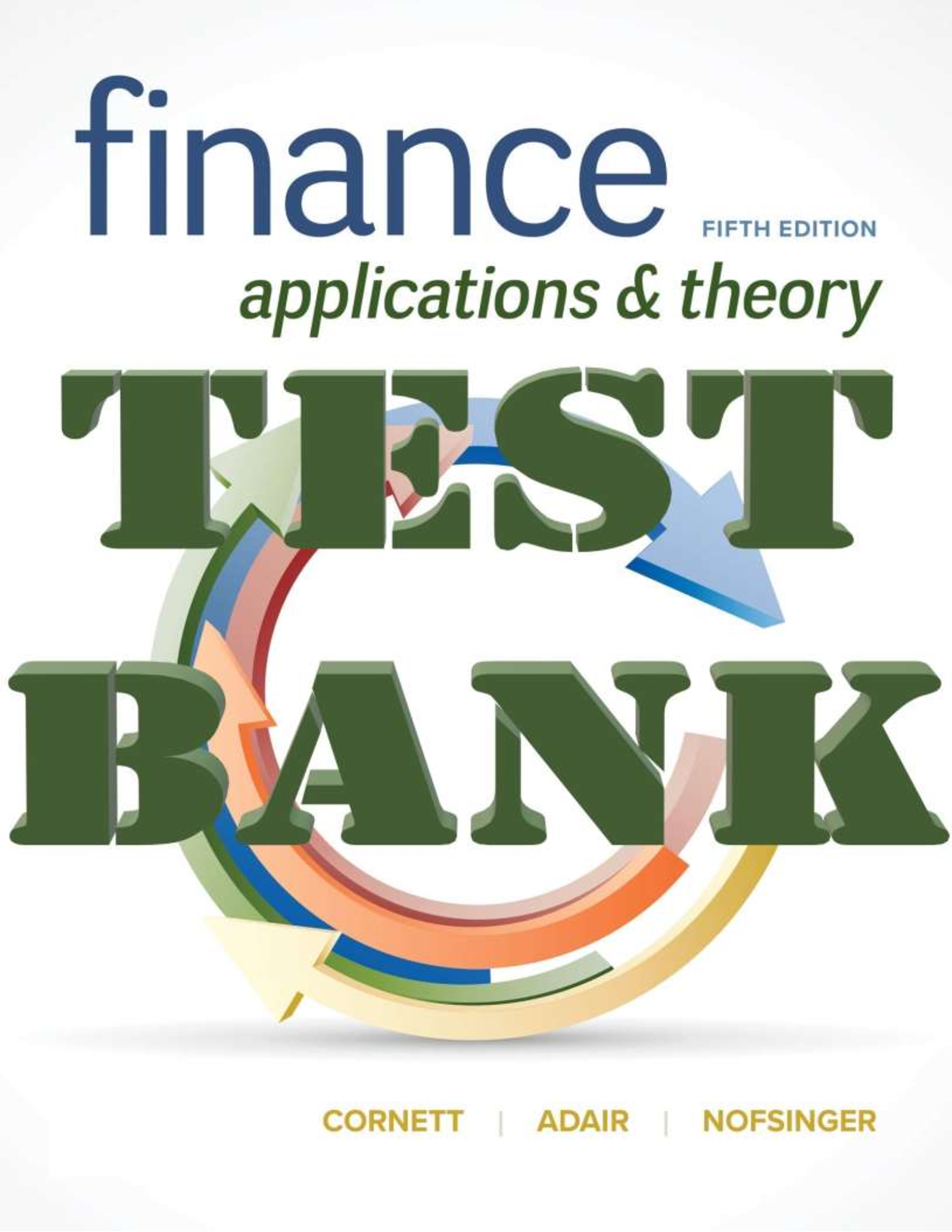Health Care > TEST BANK > Bates_12th_edition_Test_Bank_Chapters_1_through_20.doc (All)
Bates_12th_edition_Test_Bank_Chapters_1_through_20.doc
Document Content and Description Below
Bates’ Guide to Physical Examination and History Taking, 12th Edition Chapter 1: Overview: Physical Examination and History Taking Multiple Choice 1. For which of the following patients would a c... omprehensive health history be appropriate? A) A new patient with the chief complaint of “I sprained my ankle” B) An established patient with the chief complaint of “I have an upper respiratory infection” C) A new patient with the chief complaint of “I am here to establish care” D) A new patient with the chief complaint of “I cut my hand” Ans: C Chapter: 01 Page and Header: 4, Patient Assessment: Comprehensive or Focused Feedback: This patient is here to establish care, and because she is new to you, a comprehensive health history is appropriate. 2. The components of the health history include all of the following except which one? A) Review of systems B) Thorax and lungs C) Present illness D) Personal and social items Ans: B Chapter: 01 Page and Header: 4, Patient Assessment: Comprehensive or Focused Feedback: The thorax and lungs are part of the physical examination, not part of the health history. The others answers are all part of a complete health history. 3. Is the following information subjective or objective? Mr. M. has shortness of breath that has persisted for the past 10 days; it is worse with activity and relieved by rest. A) Subjective B) Objective Ans: A Chapter: 01 Page and Header: 6, Differences Between Subjective and Objective Data Feedback: This is information given by the patient about the circumstances of his chief complaint. It does not represent an objective observation by the examiner. 4. Is the following information subjective or objective? Mr. M. has a respiratory rate of 32 and a pulse rate of 120. A) Subjective B) Objective Ans: B Chapter: 01 Page and Header: 6, Differences Between Subjective and Objective Data Feedback: This is a measurement obtained by the examiner, so it is considered objective data. The patient is unlikely to be able to give this information to the examiner. 5. The following information is recorded in the health history: “The patient has had abdominal pain for 1 week. The pain lasts for 30 minutes at a time; it comes and goes. The severity is 7 to 9 on a scale of 1 to 10. It is accompanied by nausea and vomiting. It is located in the midepigastric area.” Which of these categories does it belong to? A) Chief complaint B) Present illness C) Personal and social history D) Review of systems Ans: B Chapter: 01 Page and Header: 6, The Comprehensive Adult Health History Feedback: This information describes the problem of abdominal pain, which is the present illness. The interviewer has obtained the location, timing, severity, and associated manifestations of the pain. The interviewer will still need to obtain information concerning the quality of the pain, the setting in which it occurred, and the factors that aggravate and alleviate the pain. You will notice that it does include portions of the pertinent review of systems, but because it relates directly to the complaint, it is included in the history of present illness. 6. The following information is recorded in the health history: “The patient completed 8th grade. He currently lives with his wife and two children. He works on old cars on the weekend. He works in a glass factory during the week.” Which category does it belong to? A) Chief complaint B) Present illness C) Personal and social history D) Review of systems Ans: C Chapter: 01 Page and Header: 6, The Comprehensive Adult Health History Feedback: Personal and social history information includes educational level, family of origin, current household status, personal interests, employment, religious beliefs, military history, and lifestyle (including diet and exercise habits; use of alcohol, tobacco, and/or drugs; and sexual preferences and history). All of this information is documented in this example. 7. The following information is recorded in the health history: “I feel really tired.” Which category does it belong to? A) Chief complaint B) Present illness C) Personal and social history D) Review of systems Ans: A Chapter: 01 Page and Header: 6, The Comprehensive Adult Health History Feedback: The chief complaint is an attempt to quote the patient's own words, as long as they are suitable to print. It is brief, like a headline, and further details should be sought in the present illness section. The above information is a chief complaint. 8. The following information is recorded in the health history: “Patient denies chest pain, palpitations, orthopnea, and paroxysmal nocturnal dyspnea.” Which category does it belong to? A) Chief complaint B) Present illness C) Personal and social history D) Review of systems Ans: D Chapter: 01 Page and Header: 6, The Comprehensive Adult Health History Feedback: Review of systems documents the presence or absence of common symptoms related to each major body system. The absence of cardiac symptoms is listed in the above example. 9. The following information is best placed in which category? “The patient has had three cesarean sections.” A) Adult illnesses B) Surgeries C) Obstetrics/gynecology D) Psychiatric Ans: B Chapter: 01 Page and Header: 9, Past History Feedback: A cesarean section is a surgical procedure. Approximate dates or the age of the patient at the time of the surgery should also be recorded. 10. The following information is best placed in which category? “The patient had a stent placed in the left anterior descending artery (LAD) in 1999.” A) Adult illnesses B) Surgeries C) Obstetrics/gynecology D) Psychiatric Ans: A Chapter: 01 Page and Header: 9, Past History Feedback: The adult illnesses category is reserved for chronic illnesses, significant hospitalizations, significant injuries, and significant procedures. A stent is a major procedure but does not involve a surgeon. 11. The following information is best placed in which category? “The patient was treated for an asthma exacerbation in the hospital last year; the patient has never been intubated.” A) Adult illnesses B) Surgeries C) Obstetrics/gynecology D) Psychiatric Ans: A Chapter: 01 Page and Header: 9, Past History Feedback: This is information about a significant hospitalization and should be placed in the adult illnesses section. If the patient is being seen for an asthma exacerbation, you may consider placing this information in the present illness section, because it relates to the chief complaint at that visit. Bates’ Guide to Physical Examination and History Taking, 12th Edition Chapter 2: Clinical Reasoning, Assessment, and Recording Your Findings Multiple Choice 1. A patient presents for evaluation of a sharp, aching chest pain which increases with breathing. Which anatomic area would you localize the symptom to? A) Musculoskeletal B) Reproductive C) Urinary D) Endocrine Ans: A Chapter: 02 Page and Header: 27, Assessment and Plan: The Process of Clinical Reasoning Feedback: Chest pain may be due to a musculoskeletal condition, such as costochondritis or intercostal muscle cramp. This would be worsened by motion of the chest wall. Pleuritic chest pain is also a sharp chest pain which increases with a deep breath. This type of pain can occur with inflammation of the pleura from pneumonia or other conditions and pulmonary embolus. 2. A patient comes to the emergency room for evaluation of shortness of breath. To which anatomic region would you assign the symptom? A) Reproductive B) Urinary C) Cardiac D) Hematologic Ans: C Chapter: 02 Page and Header: 27, Assessment and Plan: The Process of Clinical Reasoning Feedback: Cardiac disorders such as congestive heart failure are the most likely on this list to result in shortness of breath. There are cases within the other categories which may also result in shortness of breath, such as anemia in the hematologic category, pregnancy in the reproductive category, or sepsis with UTI in the urinary category. This demonstrates the “tension” in clinical reasoning between making sure all possibilities are covered, while still being able to pick the most likely cause. 3. A patient presents for evaluation of a cough. Which of the following anatomic regions can be responsible for a cough? A) Ophthalmologic B) Auditory C) Cardiac D) Endocrine Ans: C Chapter: 02 Page and Header: 27, Assessment and Plan: The Process of Clinical Reasoning Feedback: The cardiac system can cause a cough if the patient has congestive heart failure. This results in fluid buildup in the lungs, which in turn can cause a cough that produces pink, frothy sputum. A foreign body in the ear may also cause a cough by stimulating Arnold's branch of the vagus nerve, but this is less likely to be seen clinically than heart failure. 4. A 22-year-old advertising copywriter presents for evaluation of joint pain. The pain is new, located in the wrists and fingers bilaterally, with some subjective fever. The patient denies a rash; she also denies recent travel or camping activities. She has a family history significant for rheumatoid arthritis. Based on this information, which of the following pathologic processes would be the most correct? A) Infectious B) Inflammatory C) Hematologic D) Traumatic Ans: B Chapter: 02 Page and Header: 27, Assessment and Plan: The Process of Clinical Reasoning Feedback: The description is most consistent with an inflammatory process, although all the other etiologies should be considered. Lyme disease is an infection which commonly causes arthritis, hemophilia is a hematologic condition which can cause bleeding in the joints, and trauma can obviously cause joint pain. Your clinical reasoning skills are important for sorting through all of the data to arrive at the most likely conclusion. 5. A 47-year-old contractor presents for evaluation of neck pain, which has been intermittent for several years. He normally takes over-the-counter medications to ease the pain, but this time they haven't worked as well, and he still has discomfort. He recently wallpapered the entire second floor in his house, which caused him great discomfort. The pain resolved with rest. He denies fever, chills, rash, upper respiratory symptoms, trauma, or injury to the neck. Based on this description, what is the most likely pathologic process? A) Infectious B) Neoplastic C) Degenerative D) Traumatic Ans: C Chapter: 02 Page and Header: 27, Assessment and Plan: The Process of Clinical Reasoning Feedback: The description is most consistent with degenerative arthritis in the neck. The patient has had intermittent symptoms and the questions asked to elicit pertinent negative and positive findings are negative for infectious, traumatic, or neoplastic disease. 6. A 15-year-old high school sophomore comes to the clinic for evaluation of a 3-week history of sneezing; itchy, watery eyes; clear nasal discharge; ear pain; and nonproductive cough. Which is the most likely pathologic process? A) Infection B) Inflammation C) Allergic D) Vascular Ans: C Chapter: 02 Page and Header: 27, Assessment and Plan: The Process of Clinical Reasoning Feedback: This description is most consistent with allergic rhinitis. 7. A 19-year-old-college student presents to the emergency room with fever, headache, and neck pain/stiffness. She is concerned about the possibility of meningococcal meningitis. Several of her dorm mates have been vaccinated, but she hasn't been. Which of the following physical examination descriptions is most consistent with meningitis? A) Head is normocephalic and atraumatic, fundi with sharp discs, neck supple with full range of motion B) Head is normocephalic and atraumatic, fundi with sharp discs, neck with paraspinous muscle spasm and limited range of motion to the right C) Head is normocephalic and atraumatic, fundi with blurred disc margins, neck tender to palpation, unable to perform range of motion D) Head is normocephalic and atraumatic, fundi with blurred disc margins, neck supple with full range of motion Ans: C Chapter: 02 Page and Header: 27, Assessment and Plan: The Process of Clinical Reasoning Feedback: Blurred disc margins are consistent with papilledema, and neck tenderness and lack of range of motion are consistent with neck stiffness, which in this scenario is likely to be caused by meningeal inflammation. Later, you will learn about Kernig's and Brudzinski's signs, which are helpful in testing for meningeal irritation on examination. 8. A 37-year-old nurse comes for evaluation of colicky right upper quadrant abdominal pain. The pain is associated with nausea and vomiting and occurs 1 to 2 hours after eating greasy foods. Which one of the following physical examination descriptions would be most consistent with the diagnosis of cholecystitis? A) Abdomen is soft, nontender, and nondistended, without hepatosplenomegaly or masses. B) Abdomen is soft and tender to palpation in the right lower quadrant, without rebound or guarding. C) Abdomen is soft and tender to palpation in the right upper quadrant with inspiration, to the point of stopping inspiration, and there is no rebound or guarding. D) Abdomen is soft and tender to palpation in the mid-epigastric area, without rebound or guarding. Ans: C Chapter: 02 Page and Header: 27, Assessment and Plan: The Process of Clinical Reasoning Feedback: In cholecystitis, the pain, which originates from the gallbladder, is located in the right upper quadrant. Severity of pain with inspiration that is sufficient to stop further inhalation is also known as Murphy's sign, which, if present, is further indicative of inflammation of the gallbladder. 9. A 55-year-old data entry operator comes to the clinic to establish care. She has the following symptoms: headache, neck pain, sinus congestion, sore throat, ringing in ears, sharp brief chest pains at rest, burning abdominal pain with spicy foods, constipation, urinary frequency that is worse with coughing and sneezing, and swelling in legs. This cluster of symptoms is explained by: A) One disease process B) More than one disease process Ans: B Chapter: 02 Page and Header: 38, The Challenges of Clinical Data Feedback: The patient appears to have several possible conditions: allergic rhinitis, arthritis, conductive hearing loss, pleuritic chest pains, heartburn, stress urinary incontinence, and venous stasis, among other conditions. Although we always try, it is very difficult to assign all of these symptoms to one cohesive diagnosis. 10. A 62-year-old teacher presents to the clinic for evaluation of the following symptoms: fever, headache, sinus congestion, sore throat, green nasal discharge, and cough. This cluster of symptoms is best explained by: A) One disease process B) More than one disease process Ans: A Chapter: 02 Page and Header: 38, The Challenges of Clinical Data Feedback: This cluster of symptoms is most consistent with sinusitis. The chance that all of these symptoms are caused by multiple synchronous conditions in the same patient is much less than the possibility of having one problem which accounts for all of them. 11. Steve has just seen a 5-year-old girl who wheezes when exposed to cats. The patient's family history is positive for asthma. You think the child most likely has asthma. What have you just accomplished? A) You have tested your hypothesis. B) You have developed a plan. C) You have established a working diagnosis. D) You have created a hypothesis. Ans: D Chapter: 02 Page and Header: 27, Assessment and Plan: The Process of Clinical Reasoning Feedback: As you go through a history and examination, you will start to generate ideas to explain the patient's symptoms. It is best to keep an open mind and make as many hypotheses as you can, to avoid missing a possibility. A common mistake is to latch onto one idea too early. Once you have committed your mind to a diagnosis, it is difficult to change to another. To think about looking for wheezes on examination would be an example of testing your new hypothesis. Starting a patient on an inhaled medicine would be a plan. It is too early to commit to a working diagnosis, given the amount of information you have gathered. 12. Ms. Washington is a 67-year-old who had a heart attack last month. Now she complains of shortness of breath and not being able to sleep in a flat position (orthopnea). On examination you note increased jugular venous pressure, an S3 gallop, crackles low in the lung fields, and swollen ankles (edema). This is an example of a: A) Pathophysiologic problem B) Psychopathologic problem Ans: A Chapter: 02 Page and Header: 38, The Challenges of Clinical Data Feedback: This is an example of a pathophysiologic problem because Ms. Washington's symptoms are consistent with a pathophysiologic process. The heart attack reduced the ability of her heart to handle her volume status and subsequently produced the many features of congestive heart failure. 13. On the way to see your next patient, you glance at the calendar and make a mental note to buy a Mother's Day card. Your patient is Ms. Hernandez, a 76-year-old widow who lost her husband in May, two years ago. She comes in today with a headaches, abdominal pain, and general malaise. This happened once before, about a year ago, according to your detailed office notes. You have done a thorough evaluation but are unable to arrive at a consistent picture to tie these symptoms together. This is an example of a: A) Pathophysiologic problem B) Psychopathologic problem Ans: B Chapter: 02 Page and Header: 38, The Challenges of Clinical Data Feedback: It is not uncommon for patients to experience psychopathologic symptoms around the anniversary of a traumatic event. The time of year and the lack of an obvious connection between Ms. Hernandez's symptoms would make you consider this as a possibility. You will note that although this might have been an early consideration in your hypothesis generation, it is key to convince yourself that there is not a physiologic explanation for these symptoms, by performing a careful history and examination. 14. Mr. Larson is a 42-year-old widowed father of two children, ages 4 and 11. He works in a sales office to support his family. Recently he has injured his back and you are thinking he would benefit from physical therapy, three times a week, for an hour per session. What would be your next step? A) Write the physical therapy prescription. B) Have your office staff explain directions to the physical therapy center. C) Discuss the plan with Mr. Larson. D) Tell Mr. Larson that he will be going to physical therapy three times a week. Ans: C Chapter: 02 Page and Header: 30, Develop a Plan Agreeable to the Patient Feedback: You should discuss your proposed plan with the patient before implementing it. In this case, you and Mr. Larson will need to weigh the benefit of physical therapy against the ability to provide for his family. You may need to consider other ways of helping the patient, perhaps through prescribed back exercises he can do at home. It is a common mistake to implement a plan without coming to an agreement with the patient first. 15. You are seeing an elderly man with multiple complaints. He has chronic arthritis, pain from an old war injury, and headaches. Today he complains of these pains, as well as dull chest pain under his sternum. What would the order of priority be for your problem list? A) Arthritis, war injury pain, headaches, chest pain B) War injury pain, arthritis, headaches, chest pain C) Headaches, arthritis, war injury pain, chest pain D) Chest pain, headaches, arthritis, war injury pain Ans: D Chapter: 02 Page and Header: 37, Generating the Problem List Feedback: The problem list should have the most active and serious problem first. This new [Show More]
Last updated: 1 year ago
Preview 1 out of 209 pages
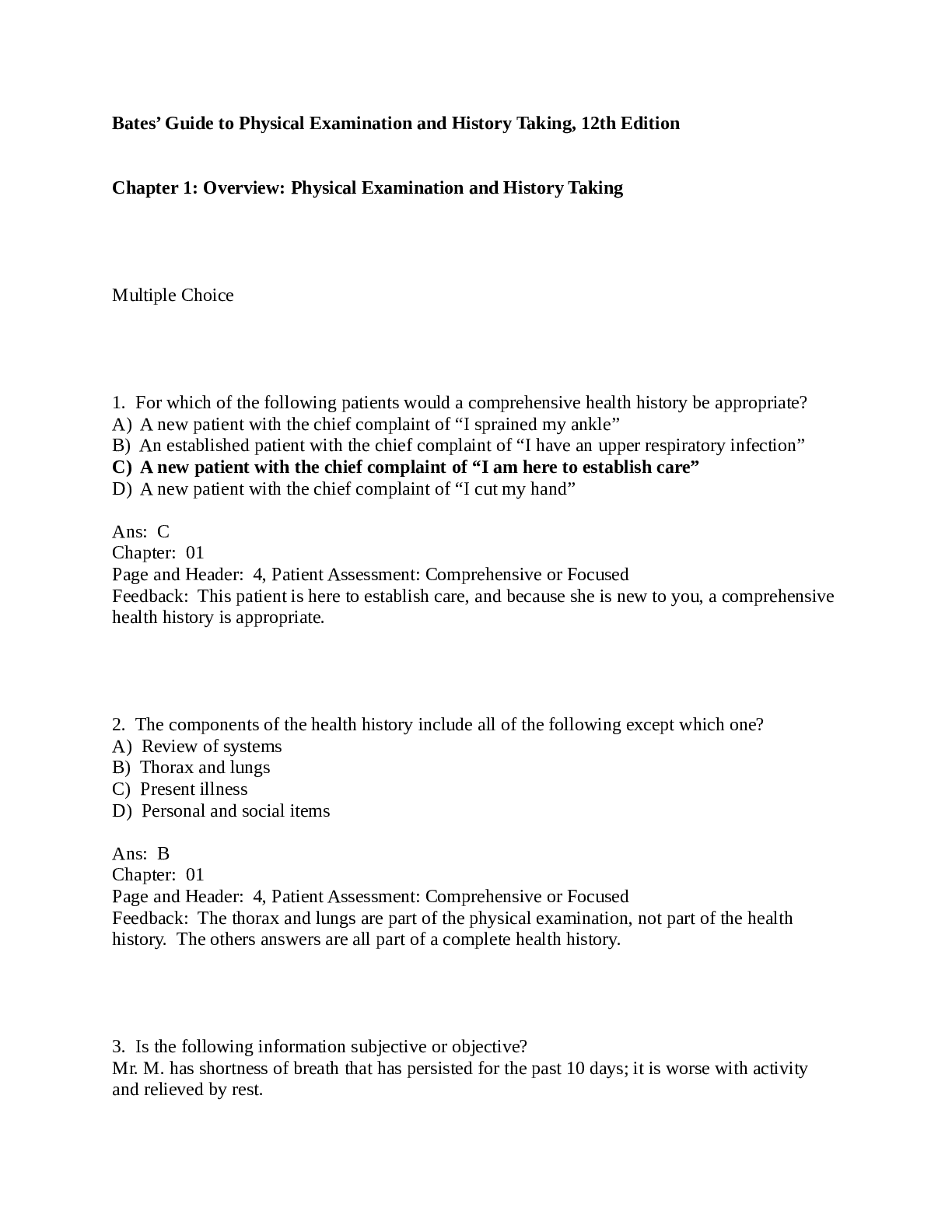
Reviews( 0 )
Document information
Connected school, study & course
About the document
Uploaded On
Jun 26, 2022
Number of pages
209
Written in
Additional information
This document has been written for:
Uploaded
Jun 26, 2022
Downloads
0
Views
88

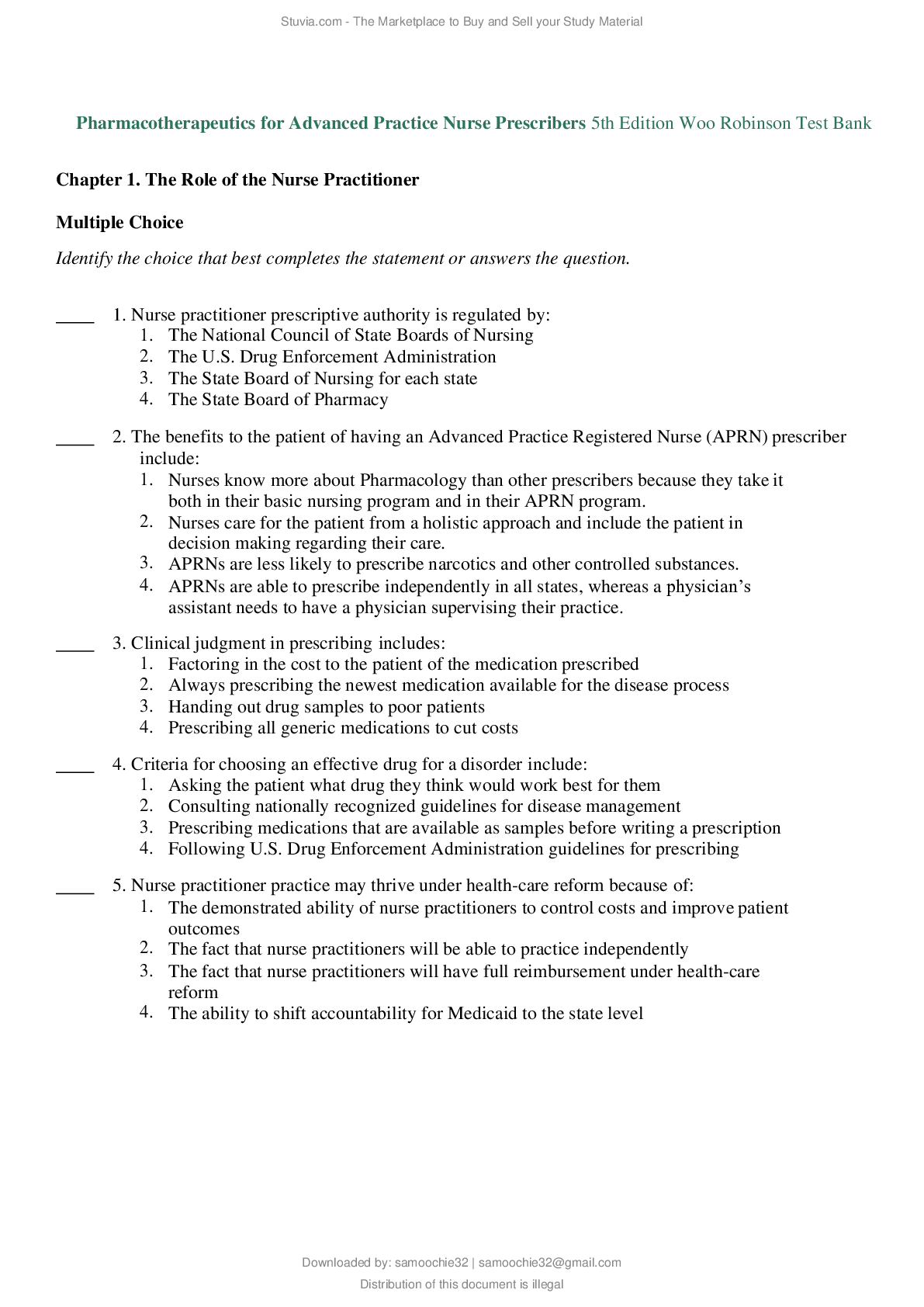
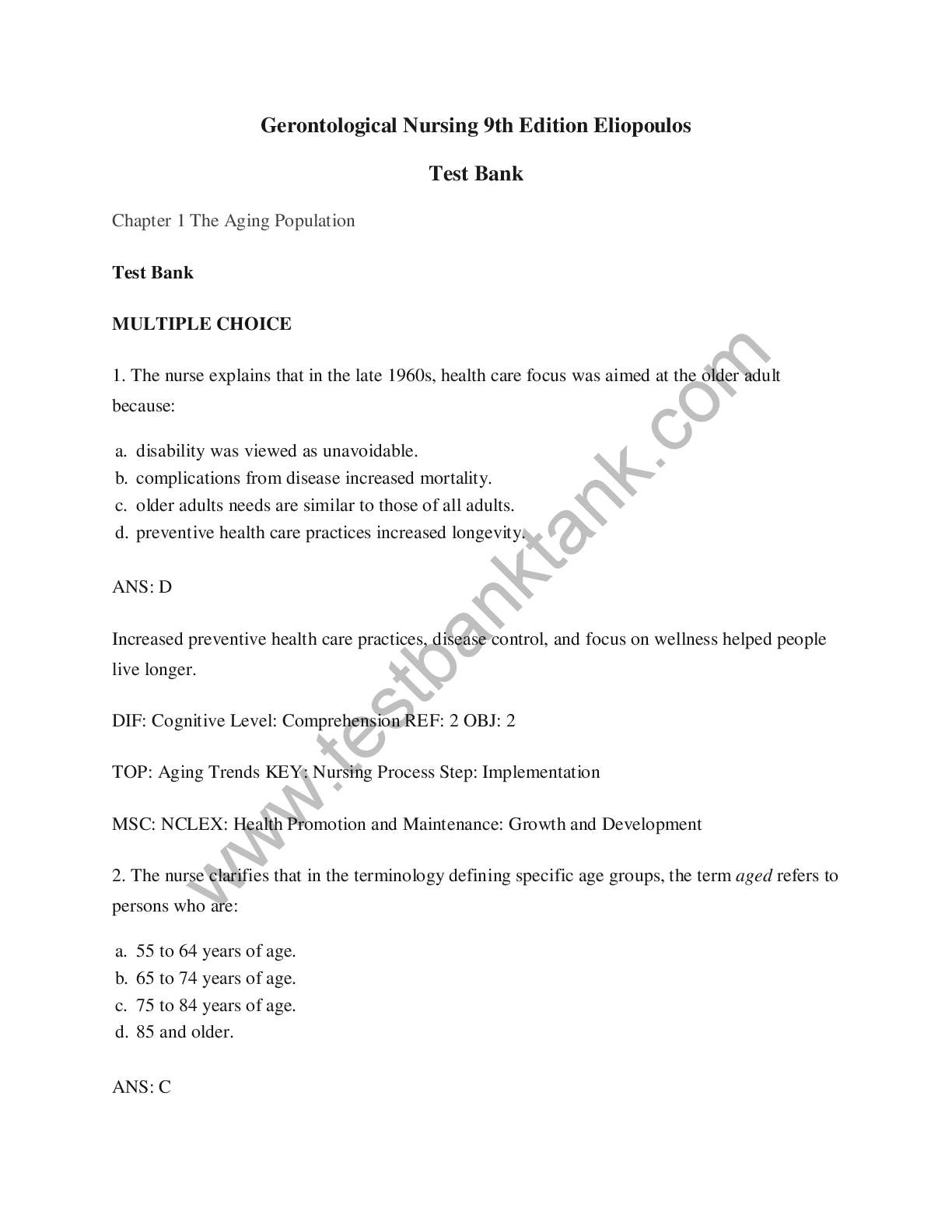




 LATEST VERSION 2022.png)

